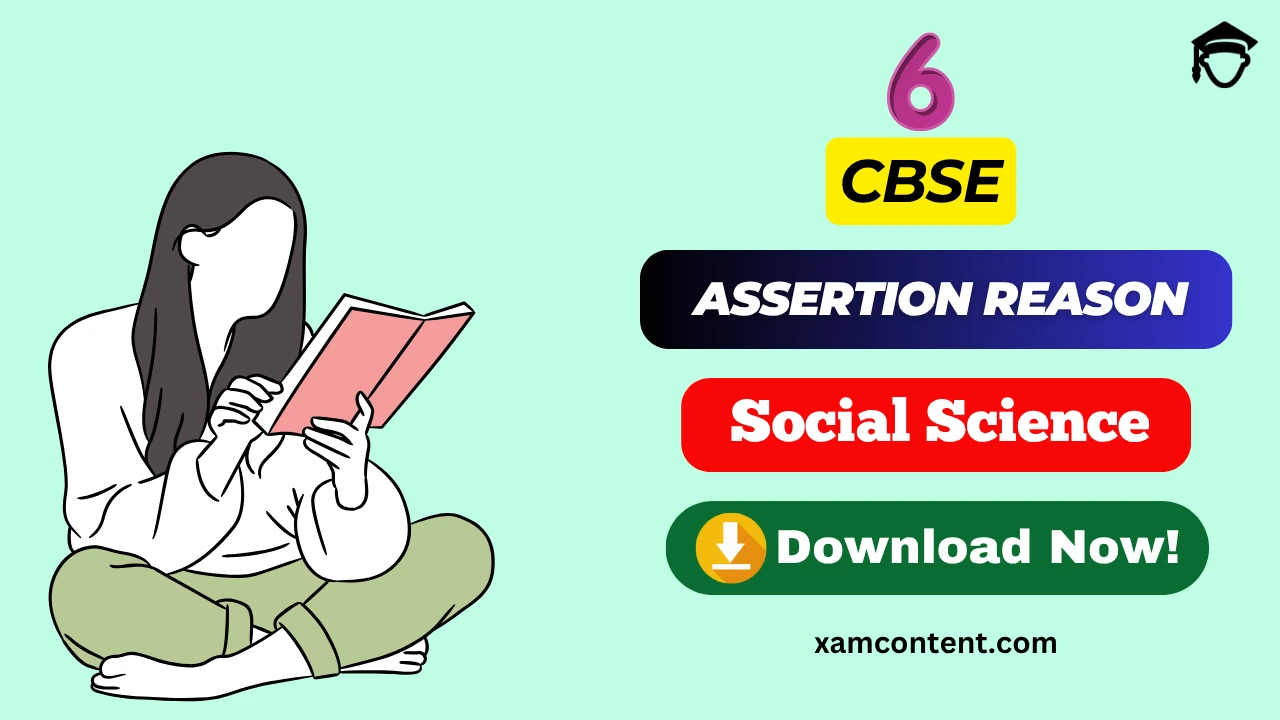Last Updated on November 16, 2025 by XAM CONTENT
Hello students, we are providing assertion reason questions for class 6. Assertion Reason questions are the new question format that is introduced in CBSE board. The resources for assertion reason questions are very less. So, to help students we have created chapterwise assertion reason questions for class 6 Social Science. In this article, you will find assertion reason questions for CBSE Class 6 Social Science Chapter 5 India, that is Bharat. It is a part of Assertion Reason Questions for CBSE Class 6 Social Science Series.
| Chapter | India, that is Bharat |
| Type of Questions | Assertion Reason Questions |
| Nature of Questions | Competency Based Questions |
| Board | CBSE |
| Class | 9 |
| Subject | Social Science |
| Useful for | Class 6 Studying Students |
| Answers provided | Yes |
| Difficulty level | Mentioned |
| Important Link | Class 6 Social Science Chapterwise Assertion Reason |
Assertion Reason Questions on India, that is Bharat
Q1. Assertion (A): India is the seventh-largest country in the world by area.
Reason (R): It stretches from the Himalayas in the north to the Indian Ocean in the south.
(a) Both A and R are true and R is the correct explanation of A.
(b) Both A and R are true but R is not the correct explanation of A.
(c) A is true but R is false.
(d) A is false but R is true.
Show Answer
Ans: (a)
Explanation: Both statements are true and related; India’s vast geographical span covers diverse landforms from north to south.
Q2. Assertion (A): India lies entirely in the Northern Hemisphere.
Reason (R): The Tropic of Cancer passes roughly through the middle of the country.
(a) Both A and R are true and R is the correct explanation of A.
(b) Both A and R are true but R is not the correct explanation of A.
(c) A is true but R is false.
(d) A is false but R is true.
Show Answer
Ans: (a)
Explanation: Both statements are true and connected; the Tropic of Cancer at 23.5°N divides India almost equally into two halves.
Q3. Assertion (A): India shares its longest border with China.
Reason (R): India’s longest border is actually shared with Bangladesh.
(a) Both A and R are true and R is the correct explanation of A.
(b) Both A and R are true but R is not the correct explanation of A.
(c) A is true but R is false.
(d) A is false but R is true.
Show Answer
Ans: (d)
Explanation: The assertion is false; Bangladesh shares the longest land boundary with India, not China.
Q4. Assertion (A): The southernmost point of India is Indira Point.
Reason (R): It is located in the Andaman and Nicobar Islands.
(a) Both A and R are true and R is the correct explanation of A.
(b) Both A and R are true but R is not the correct explanation of A.
(c) A is true but R is false.
(d) A is false but R is true.
Show Answer
Ans: (a)
Explanation: Both are true and related; Indira Point in Great Nicobar is India’s southern tip submerged partially by sea rise.
Q5. Assertion (A): The Indian mainland lies between latitudes 8°N and 37°N.
Reason (R): This wide latitudinal extent causes variation in climate and daylight.
(a) Both A and R are true and R is the correct explanation of A.
(b) Both A and R are true but R is not the correct explanation of A.
(c) A is true but R is false.
(d) A is false but R is true.
Show Answer
Ans: (a)
Explanation: Both are true and related; India’s latitudinal spread leads to differences in temperature and day length across regions.
Q6. Assertion (A): The Himalayas form India’s eastern boundary.
Reason (R): They stretch along the northern frontier of the country.
(a) Both A and R are true and R is the correct explanation of A.
(b) Both A and R are true but R is not the correct explanation of A.
(c) A is true but R is false.
(d) A is false but R is true.
Show Answer
Ans: (d)
Explanation: The reason is true; the Himalayas lie in the north, not the east, forming India’s northern boundary.
Q7. Assertion (A): India is divided into 29 states and 7 union territories.
Reason (R): Each state has its own government, while union territories are governed by the central government.
(a) Both A and R are true and R is the correct explanation of A.
(b) Both A and R are true but R is not the correct explanation of A.
(c) A is true but R is false.
(d) A is false but R is true.
Show Answer
Ans: (c)
Explanation: The reason is true but the assertion is outdated; after reorganization, India has 28 states and 8 union territories.
Q8. Assertion (A): The Indian Ocean is named after India.
Reason (R): India’s central location and ancient maritime trade routes contributed to this naming.
(a) Both A and R are true and R is the correct explanation of A.
(b) Both A and R are true but R is not the correct explanation of A.
(c) A is true but R is false.
(d) A is false but R is true.
Show Answer
Ans: (a)
Explanation: Both are true and related; India’s geographic prominence in the Indian Ocean led to the name.
We hope the given assertion reason questions with Answers for India, that is Bharat Class 6 helps you in your learning.

Also check
- Class 6 Social Science Assertion Reason Questions Chapter 14 – Economic Activities Around Us
- Class 6 Social Science Assertion Reason Questions Chapter 13 – The Value of Work
- Class 6 Social Science Assertion Reason Questions Chapter 12 – Grassroots Democracy Part 3 Local Government in Urban Areas
- Class 6 Social Science Assertion Reason Questions Chapter 11 – Grassroots Democracy Part 2 Local Government in Rural Areas
- Class 6 Social Science Assertion Reason Questions Chapter 10 – Grassroots Democracy Part 1 Governance
- Class 6 Social Science Assertion Reason Questions Chapter 9 – Family and Community
- Class 6 Social Science Assertion Reason Questions Chapter 8 – Unity in Diversity
- Class 6 Social Science Assertion Reason Questions Chapter 7 – India’s Cultural Roots
- Class 6 Social Science Assertion Reason Questions Chapter 6 – The Beginings of Indian Civilisation
- Class 6 Social Science Assertion Reason Questions Chapter 5 – India, that is Bharat
- Class 6 Social Science Assertion Reason Questions Chapter 4 – Timeline and Sources of History
- Class 6 Social Science Assertion Reason Questions Chapter 3 – Landforms and Life
- Class 6 Social Science Assertion Reason Questions Chapter 2 – Ocean and Continents
- Class 6 Social Science Assertion Reason Questions Chapter 1 – Locating Places on Earth
Topics from which assertion reason questions may be asked
- Ancient names and concept of India
- Sapta Sindhava, Jambudvīpa and Bhāratavarṣa
- Evidence from texts and inscriptions
Assertion reason questions from the above given topic may be asked.

You may also like

Frequently Asked Questions (FAQs) on India, that is Bharat Assertion Reason Questions Class 6
Q1: What are Assertion Reason Questions in Class 6 Social Science?
A1: Assertion Reason Questions are a new type of competency-based questions where students are given two statements — an Assertion (A) and a Reason (R). Students must decide whether each statement is true and whether the Reason correctly explains the Assertion.
Q2: How can Assertion Reason Questions help in exam preparation?
A2: These questions help students think critically, understand cause–effect relationships, and go beyond rote learning. They strengthen conceptual clarity in topics like History, Geography, and Civics by testing logical connections between facts.
Q3: How should students approach Assertion Reason Questions?
A3: Students should first read both statements carefully, identify whether each is true or false, and then check if the Reason actually explains the Assertion. Practicing chapter-wise Assertion Reason sets regularly improves accuracy and speed.
Q4: Are Assertion Reason Questions included in CBSE Class 6 syllabus?
A4: While Assertion Reason Questions are not directly mentioned in the NCERT syllabus, they are part of the new competency-based assessment pattern introduced by CBSE to promote conceptual understanding and analytical thinking.
Q5: What types of topics are covered in Class 6 Social Science Assertion Reason Questions?
A5: Topics include key chapters from History (e.g., What, Where, How and When?), Geography (e.g., The Earth in the Solar System), and Civics (e.g., Understanding Diversity) — focusing on reasoning, relationships, and application of knowledge.
Q6: Where can I find Assertion Reason Questions for Class 6 Social Science Chapter-wise?
A6: You can access free, chapter-wise Assertion Reason Questions with detailed explanations at xamcontent.com and physicsgurukul.com. These resources are designed as per the latest CBSE competency-based exam format.
Q7: Why has the Indian subcontinent been known by many names?
A7: Different peoples and cultures, both within and outside the region, described the land in their own languages and times. As a result, names like Sapta Sindhava, Jambudvipa, Bhāratavarṣha, Hind and India have all been used for the Indian subcontinent.
Q8: What is the meaning of the name “Bhāratavarṣha”?
A8: Bhāratavarṣha means “the land of the Bharatas.” It refers to the region ruled or inhabited by the Bharata people and, in later texts, it came to mean the entire Indian subcontinent.
Q9: How did the name “India” evolve from the word “Sindhu”?
A9: The river Sindhu was called “Hindu” or “Hind” by the Persians. The Greeks adapted this as “Indoi” or “Indike,” and from these forms, the word “India” developed in later European languages.
Q10: How does the Indian Constitution refer to our country?
A10: The Indian Constitution begins with the phrase “India, that is Bharat,” which officially recognises both “India” and “Bharat” as names of our country.
Q11: Why did ancient texts use the name “Jambudvipa” for India?
A11: “Jambudvipa” means “the island of the jamun tree.” Since the jamun tree was common and well known in this region, ancient texts used Jambudvipa to refer to the broad land area of the Indian subcontinent.



